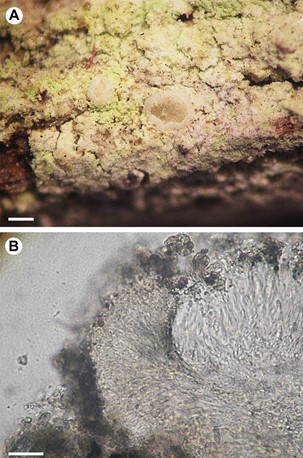Tylocliostomum viridifarinosum van den Boom & Magain, sp. nov. (Fig. 3A–B)
MycoBank number: MB 834080; Index Fungorum number: IF 834080; Facesoffungi number: FoF 13336;
Diagnosis: Thallus, thin, continuous, farinose, granules (goniocysts) 8‒20 µm diam., green, apothecia 0.15‒0.4 mm diam., flat to convex, proper margin often visible, concolorous with or paler than disc, becoming excluded, disc white to pale cream or medium grey, sometimes with bluish grey tinge, ascospores narrow ellipsoid to bacillar, 11‒15(‒17) × 2.5‒3(‒3.2) µm, 1-septate, thin-walled; no chemical compounds detected.
Type: Portugal, Madeira, NW of Funchal, road (ER228), from Ribeira Brava to São Vicente, 1.5 km N of Boca da Encumeada, Chão dos Louros, very big picnic area with mature trees along laurisilva, 32°45.62’N, 17°00.98’W, 825 m, 5 April 2019, P. & B. van den Boom 58193 (LG – holotype; LISU, herb. van den Boom – isotypes).
Description. Thallus thin, continuous, farinose, granules (goniocysts) 8‒20 µm diam., bright green. Prothallus not present. Photobiont chlorophycean, cells 5‒11 µm diam. Apothecia usually present, 0.15‒0.4 mm diam., flat to slightly convex. Proper margin often visible, sometimes well developed, up to 50 µm wide and present especially in young apothecia, the concolorous with or somewhat paler than disc, often becoming excluded. Disc white to pale cream, very pale yellowish, sometimes with bluish grey tinge, scattered over apothecia, or completely medium grey. Excipulum sometimes well developed and rather thick, 40‒60 µm wide, with small prosoplectenchym cells filled with fine granular crystals (studied in polarised light), hyaline. Hymenium 45‒60 µm high, hyaline. Epithecium pale greyish brown to very pale brown or pale bluish brown, filled with fine crystals (studied in polarised light). Hypothecium hyaline, ~50 µm high. Paraphyses simple, usually septate, 1.2‒1.8 µm wide, apices sometimes some- what widened, 2.5‒4 µm diam., tips hyaline to sometimes pale bluish brownish. Asci cylindrical-clavate to clavate, 8-spored, Catillaria-type, sometimes with relatively small ocular chamber, 23‒35 × 12‒15 µm. Ascospores narrow ellipsoid to bacillar, 11‒15(‒17) × 2.5‒3(‒3.2) µm, 1-septate, thin-walled, often with two oil droplets in one cell. Pycnidia not detected. No chemical compounds detected.
Etymology. The epithet refers to the habitus of the thallus, which is farinose and clearly green.
Habitat and distribution. This new species is abundantly present in the type locality, growing on twigs of Erica shrubs. Cliomegalaria symmictoides and Endohyalina ericina, whose presence is revealed by many or few apothecia, respectively, share this habitat.
Notes. In the field, Tylocliostomum viridifarinosum is easily mistaken for Cliomegalaria symmictoides because the apothecia are cream-coloured and slightly convex and appressed, but the thallus differs, being areolate, not farinose, with a somewhat shiny upper surface, and the ascospores are thick-walled, 1-septate and much wider (4.5‒6.5 µm). The habitus of the new genus somewhat resembles Cliostomum, especially if the ascomata are pale in the latter. The hyaline ascospores in Cliostomum griffithii are usually also 1-septate, but sometimes wider, reaching 3.5 µm in width versus 3.2 µm maximum in T. viridifarinosum. Cliostomum species have usually numerous, conspicuous black pycnidia, which seem to be absent in the new species. The relationship with the genus Tylothallia is unexpected, because T. biformigera, known from the temperate zone of the Northern Hemi- sphere, develops a thick rimose thallus with dark brown apothecia, on acidic rock (Smith et al. 2009).

Figure 3. Tylocliostomum viridifarinosum (holotype). A – habitus; B – excipulum. Scales: A = 0.2 mm; B = 20 µm.
